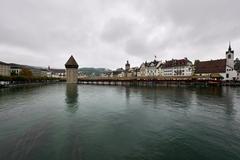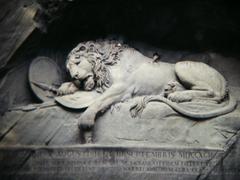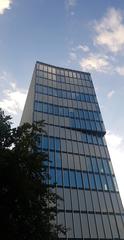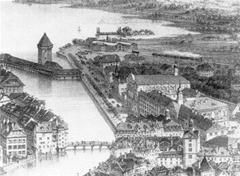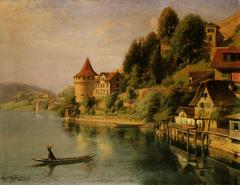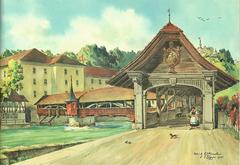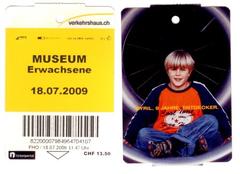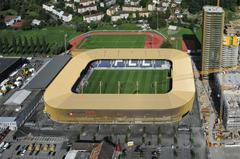Allwindenturm Visiting Hours, Tickets, and Travel Guide: Lucerne Historical Sites
Date: 14/06/2025
Introduction
Nestled in the enchanting city of Lucerne, Switzerland, the Allwindenturm (also known as Allenwindenturm) is a quietly impressive testament to the city’s medieval heritage. Part of the iconic Musegg Wall, this tower offers a glimpse into Lucerne’s storied past, its evolving role from a defensive structure to a hub for local cultural traditions. Although less famous than some of its neighboring towers, Allwindenturm is deeply woven into the fabric of Lucerne’s history—serving as a guardian, community meeting place, and symbol of living heritage (Luzern.com; Switzerland Highlights).
This guide provides a detailed overview of Allwindenturm’s history, architectural features, cultural significance, visiting hours, ticketing information, and practical travel tips. Whether you’re a history buff, cultural explorer, or first-time visitor to Lucerne, this article will help you plan an enriching visit to the city’s medieval heart.
Table of Contents
- Origins and Historical Context
- Architectural Features and Evolution
- Cultural Significance and Living Heritage
- Visiting Allwindenturm: Hours, Tickets, and Access
- Exploring the Musegg Wall and Nearby Attractions
- Visitor Experience and Practical Tips
- Environmental and Wildlife Considerations
- Facilities and Amenities
- Sustainable Tourism and Crowd Management
- Language and Communication
- Frequently Asked Questions (FAQ)
- Additional Resources
- Conclusion
- References
Origins and Historical Context
The Allwindenturm is one of nine surviving towers of Lucerne’s Musegg Wall—a medieval fortification constructed in the late 14th century to safeguard the city and control trade routes (Luzern.com). While the wall originally boasted around 30 towers, only nine remain today, with Allwindenturm positioned at the eastern edge (Switzerland Highlights).
Dendrochronological studies date the Allwindenturm’s roof structure to no earlier than 1540/41, placing its construction in the late Middle Ages—an era when Lucerne’s regional political and commercial influence was growing (Museggmauer Allenwindenturm; Lucerne History).
The Musegg Wall’s construction reflected Lucerne’s need for strong defenses and the desire to demarcate its urban boundary. The Allwindenturm played a strategic role in protecting the city’s eastern approaches and bolstering the wall’s defensive network.
Architectural Features and Evolution
Allwindenturm’s design is a classic example of utilitarian medieval fortification. The tower measures approximately 9.1 by 7 meters, rising to a height of 27.5 meters, with walls about 1.8 meters thick (Museggmauer Allenwindenturm). Set slightly forward from the main wall, it enabled defenders to provide flanking fire and monitor the approach from the countryside.
Unlike the ornate Zytturm (Clock Tower), Allwindenturm showcases the robust, pragmatic architecture of Swiss military engineering. Over the centuries, its function transitioned from military defense to civic uses, including a fire brigade hose-drying facility in the 19th century and, later, storage space (Museggmauer Allenwindenturm).
Since 1970, Allwindenturm has served as the headquarters and rehearsal space for two important Fasnacht (Carnival) associations, cementing its integration into Lucerne’s living cultural landscape.
Cultural Significance and Living Heritage
Allwindenturm is not only a symbol of Lucerne’s resilience but also a vibrant center for local tradition. The tower is home to the Tambourenverein Luzern (drummers’ association) and the Verein Luzerner Maskenfreunde (Mask Friends), both of which play central roles in the city’s celebrated Fasnacht Carnival (Museggmauer Allenwindenturm; hotelsempachersee.ch).
The preservation of the Musegg Wall and its towers, including Allwindenturm, is a point of pride in Lucerne—especially as many Swiss cities dismantled their medieval walls in the 19th century (Lucerne History). The wall remains an architectural and symbolic divider between Lucerne’s historic center and its modern districts.
Visiting Allwindenturm: Hours, Tickets, and Access
Visiting Hours
- Allwindenturm Interior: The interior is not open to the general public, as it is used by local cultural groups (Museggmauer Allenwindenturm).
- Musegg Wall: The wall and accessible towers are open from April 1 to October 31 each year (simskultur.eu).
Tickets and Admission
- Admission Fee: There is no fee to walk the Musegg Wall or view the Allwindenturm from outside. Some towers (e.g., Zytturm) are free to enter during open season.
- Guided Tours: Local tourism offices offer guided tours of the Musegg Wall, which may occasionally include special access to Allwindenturm for events (Luzern.com).
Access and Transportation
- Location: Eastern end of the Musegg Wall, accessible via a 10–15 minute walk from Luzern Bahnhof (main train station) or Schwanenplatz.
- Mobility: The wall and towers involve stairs and uneven surfaces; they are not wheelchair accessible.
Exploring the Musegg Wall and Nearby Attractions
The Musegg Wall is centrally located in Lucerne’s Old Town, making it easy to combine your walk with visits to:
- Other Musegg Towers: Zytturm (Clock Tower), Männli Tower, Schirmer Tower, and more—several are open for climbing and feature panoramic city views.
- Chapel Bridge (Kapellbrücke): Lucerne’s iconic covered bridge.
- Lion Monument (Löwendenkmal): Memorial to Swiss Guards.
- Old Town: Pedestrian streets, historic buildings, and local shops.
Walking tours—guided or self-guided—are highly recommended for historical context.
Visitor Experience and Practical Tips
Navigating the Musegg Wall
- Route: Main entrances are at Schirmerturm (west) and Nölliturm (northwest). Allwindenturm is between Pulver Tower and Dächliturm.
- Footwear: Wear sturdy shoes; surfaces can be slippery, especially in wet weather.
- Photography: Early morning or late afternoon provide the best light and fewer crowds. Evening walks reveal the illuminated wall’s dramatic cityscape.
Best Time to Visit
- Season: April–October is ideal for wall access; shoulder seasons (April–May, September–October) have fewer tourists.
- Weather: June temperatures range from 9°C to 22°C (48°F–72°F), with frequent rain (weather25.com). Dress in layers and bring rain gear.
Environmental and Wildlife Considerations
- Urban Nature: The Musegg Wall supports kestrels, alpine swifts, bats, wall lizards, and specialized plants (simskultur.eu).
- Visitor Etiquette: Stay on marked paths and avoid disturbing wildlife, especially during nesting season.
Facilities and Amenities
- Restrooms: Public toilets are available in Lucerne’s Old Town, but not directly at the wall.
- Food and Drink: Numerous cafés and restaurants are nearby; picnicking is allowed in designated areas.
- Souvenirs: Local shops offer Fasnacht-themed items and Lucerne memorabilia.
Sustainable Tourism and Crowd Management
- Over-Tourism: Visit outside peak times (early morning, late afternoon, or shoulder season) for a quieter experience (switzerlandinsider.com).
- Respect Heritage: Follow posted signs and avoid climbing on undesignated wall sections to help preserve historic structures.
Language and Communication
- Language: Swiss German is predominant; English is widely spoken in tourist areas.
- Signage: Most information panels are in German, with some English translations.
Frequently Asked Questions (FAQ)
Q: Can I visit inside the Allwindenturm?
A: No; the interior is reserved for local cultural associations and is not open to the public except during special events (Museggmauer Allenwindenturm).
Q: Do I need a ticket to walk the Musegg Wall or view the towers?
A: No ticket or admission fee is required for exterior viewing or wall access.
Q: Which towers can I climb?
A: Towers such as Zytturm, Männli, and Schirmer are open for interior visits in season.
Q: Is the Musegg Wall accessible for people with disabilities?
A: No; due to historic stairs and architecture, it is not wheelchair accessible.
Q: When is the best time to visit?
A: April–October, especially during shoulder seasons for fewer crowds and pleasant weather.
Additional Resources
- Luzern.com – Official tourism site for hours, events, and tours
- MeteoSwiss – Weather updates
- Weather25 – Monthly weather forecasts
- Simskultur.eu – Musegg Wall and towers overview
For travel safety tips, see Lonely Planet’s Switzerland guide.
Conclusion
The Allwindenturm is a quiet yet enduring witness to Lucerne’s medieval origins and its vibrant cultural present. While the tower’s interior is generally closed to the public, its presence along the Musegg Wall provides visitors with a unique connection to centuries of history, tradition, and architectural achievement. Exploring the Musegg Wall—especially in combination with Lucerne’s other historic sites—offers an immersive journey through the city’s past and present. For the most current information on hours, tours, and special events, consult Luzern.com or the official websites listed below. Enrich your visit with an audio guide from the Audiala app and experience Lucerne’s living heritage firsthand.
